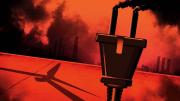There’s a problem with sustainable energy, and it will only grow with time. Now that wind and solar have become cheaper sources of electricity than fossil fuels in some places, the problem is intermittency—what to do when the wind dies or the sun goes down.
Storing extra energy in batteries can alleviate some intermittency problems, but Butler professor of environmental studies Michael McElroy believes that using renewable energy produced by utilities in working power grids to make hydrogen—a portable, storable fuel source that produces only water as a byproduct when burned in a fuel cell—is a better solution. In the journal Renewable Energy, the long-time head of the Harvard-China Project on Energy, Economy, and Environment examines steps China can take to help maximize the utility of its renewable-energy infrastructure, lower the cost of clean hydrogen fuel, and break the country’s reliance on coal. The research, McElroy says, points to ways to make renewable energy cheaper and more prevalent across the world.
China emits more greenhouse gases than any other country—but is also home to more wind- and solar-energy infrastructure than any other nation. Between 2016 and 2020, the country doubled its sustainable power production, producing as much as 400 gigawatts from these two renewable sources alone (about 80 percent of total electricity consumption in the United States). However, China’s installed equipment often operates below capacity. In 2016, for example, the country’s wind-power curtailment rate was about 21 percent—meaning the industry produced about a fifth less wind power than it was capable of.
McElroy’s study, a collaboration with lead author and visiting fellow Haiyang Lin, research associate Shaojie Song, and other Harvard-China Project collaborators, focuses on such inefficiencies in western Inner Mongolia. In winter, a coal-burning centralized system heats water that is distributed across the region for space heating. Because this process also produces electricity, the area doesn’t need as much electricity from renewable sources. The regional government “had invested in wind turbines,” McElroy explains, “but when the wind was really, really good, they were trying to turn it off.” Worse, Chinese central government policy prevents additional investments in wind power when 20 or more percent of an area’s wind power potential is curtailed. Why invest in more wind-power technology when it’s not being used?
McElroy suggests that, instead of turning off the turbines, China use this curtailed wind energy to produce zero-carbon hydrogen. This clean or “green” hydrogen could then be used in fuel cells that convert energy stored in the element into electricity for homes, buses, or cars—opening the door for cheaper, more prevalent hydrogen-fueled vehicles that outperform gasoline ones. This green hydrogen could also be used in the production of ammonia, methanol, iron, and steel. Currently, nearly 95 percent of hydrogen in China is created through coal gasification, in a process that produces twice the carbon-dioxide emissions of hydrogen produced with natural gas, the least carbon-intensive fossil fuel.
Today, using coal, it costs $1.47 to $2.23 per kilogram to produce hydrogen in China; producing clean or “green” hydrogen is about two to eight times more expensive. But McElroy believes past research has not approached “green hydrogen potential” in a holistic way. “These previous studies focused on off-grid or small-scale systems,” he writes. They didn’t consider how to integrate renewable sources into the current grid, accommodate varying wind speeds by creating more or less hydrogen, and produce this green hydrogen with better technology that would make it less expensive.
With these adjustments, China could use surplus electricity flowing through the electrical grid at times of low demand in addition to curtailed wind power to produce hydrogen, and that would cause costs to plummet. “The spectacular conclusion of the paper,” McElroy says, “is that you can produce green hydrogen in western Inner Mongolia that is competitive with the current sources….”
He estimates western Inner Mongolia can produce enough green hydrogen to meet all its needs for just $1.52 per kilogram by 2030. At this price, the green hydrogen is comparable in cost to other production methods, but with only a fraction of the environmental impact.
McElroy admits that one challenge to achieving this goal is a conflict of short- and long-term priorities. To get people back to work during its economic recovery from COVID-19, China has invested in coal-fired power plants, an easy source of jobs. So, while the central government is pushing for a coal-free future, it and provincial governments are also investing in coal now. The same problem, he says, is present in the United States, where short-term infrastructure goals can hinder investments in renewable energy.
Beyond improving the efficiency of carbon-neutral energy sources, McElroy and his colleagues are also researching ways to store and distribute green hydrogen across the world. Options they’re exploring include shipping hydrogen as a highly pressurized liquid, bonding it to the chemical toluene (from which it can later be released), and using it to make ammonia (from which hydrogen can be extracted). The way McElroy sees it, the cheaper and more accessible green hydrogen can be, the better. “So I think this is a really big deal,” he says, “and a significant path to the future.”









